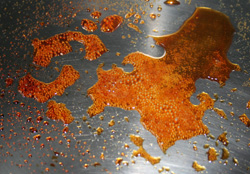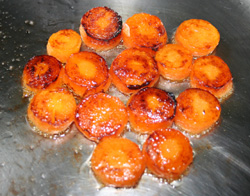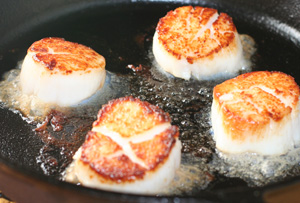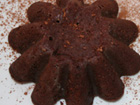What is the Caramelization?
Caramelization or caramelisation (see spelling differences) is the oxidation of sugar, a process used extensively in cooking for the resulting nutty flavor and brown color. Caramelization is a type of non-enzymatic browning reaction. As the process occurs, volatile chemicals are released producing the characteristic caramel flavor. The reaction involves the removal of water (as steam) and the break down of the sugar. The caramelization reaction depends on the type of sugar. Sucrose and glucose caramelize around 160C (320F) and fructose caramelizes at 110C (230F).

Caramelized Sugar
Caramelization temperatures?
If you looked at ice cream under a microscope, you would see see ice crystals, fat droplets, and air pockets dispersed in liquid. This foamy mixture of liquid, solid, and air is crucial to ice cream’s flavor and consistency.
To help keep this foamy microscopic structure, ice cream contains chemical ingredients called “thickening agents.” These are designed to help foam stay foamy.
| SUGAR | TEMPERATURE |
| Fructose | 110° C, 230° F |
| Galactose | 160° C, 320° F |
| Glucose | 160° C, 320° F |
| Lactose | 203° C, 397° F |
| Sucrose | 160° C, 320° F |
The highest rate of the color development is caused by fructose as caramelization of fructose starts at 110C. Baked goods made from honey or fructose syrup will therefore give a darker color.
Caramelization of sucrose starts with the melting of the sugar at high temperatures (see below) followed by foaming (boiling). Sucrose first decomposes into glucose and fructose. This is followed by a condensation step, in which the individual sugars lose water and react with each other. Hundreds of new aromatic compounds are formed having a range of complex flavors.
In the case of the caramelization of sucrose three main product groups are formed: a dehydration product, caramelan C12H18O9; and two polymers, carmelen C36H50O25 and caramelin The average molecular formula for caramelin C125H188O80.
Caramelization
Products:
2C12H22O11 =
4H20 C24H36O18 Caramelan
3C12H22O11 =Caramelization continues to be a poorly understood process Here is an overview:
equilibration of anomeric and ring forms
sucrose inversion to fructose and glucose
condensation
intramolecular bonding
isomerization of aldoses to ketoses
dehydration reactions
fragmentation reactions
unsaturated polymer formation
8H20 C36H50O25 Caramelen
Continued heating yields caramelin C125H188O80
Caramelization continues to be a poorly understood process Here is an overview:
- equilibration of anomeric and ring forms
- sucrose inversion to fructose and glucose
- condensation
- intramolecular bonding
- isomerization of aldoses to ketoses
- dehydration reactions
- fragmentation reactions
- unsaturated polymer formation
Flavors of Caramel:
Diacetyl ( 2,3-butanedione) is an important flavour compound, produced during the first stages of caramelization. Diacetyl is mainly responsible for a buttery or butterscotch flavour.
Esters and lactones which have a sweet rum like flavor.
Furans which have a nutty flavor.
Maltol has a toasty flavor.
If carmelization is allowed to proceed to far the taste of the mixture will become less sweet as the original sugar is destroyed. Eventually the flavor will turn bitter.
NOTE: Caramelization should not be confused with the Maillard reaction, in which reducing sugar reacts with amino acids.

Caramelized Carrots
Carrots have a higher natural sugar content than all other vegetables with the exception of beets. In the photo above the high sugar content produced a highly caramelized surface. Carrots are high in glucose, fructose and sucrose (depending on the breed of carrot) which promote caramelization. In the case of carrots the reaction actually contains both caramelization products and Maillard reaction products since vegetables also contain amino acids along with reducing sugars. (Note: sucrose is not a reducing sugars).
Caramelized Scallops

Scallops cooked in a cast iron pan produced excellent caramelization because of high heat retention. As in the case of carrots both caramelization and products of the Maillard Reaction are produced.
References:
(1) Overview of Caramel Colors
(2) Caramelization
Science of Cooking
See also:
Science of cooking with brown butter
How to prevent ice crystals from forming in sorbet Taste Molecules --
Science of Chocolate

NEWScience of ChocolateHow is Chocolate Made?
What are the health benefits of Chocolate?
What are the drugs in Chocolate?